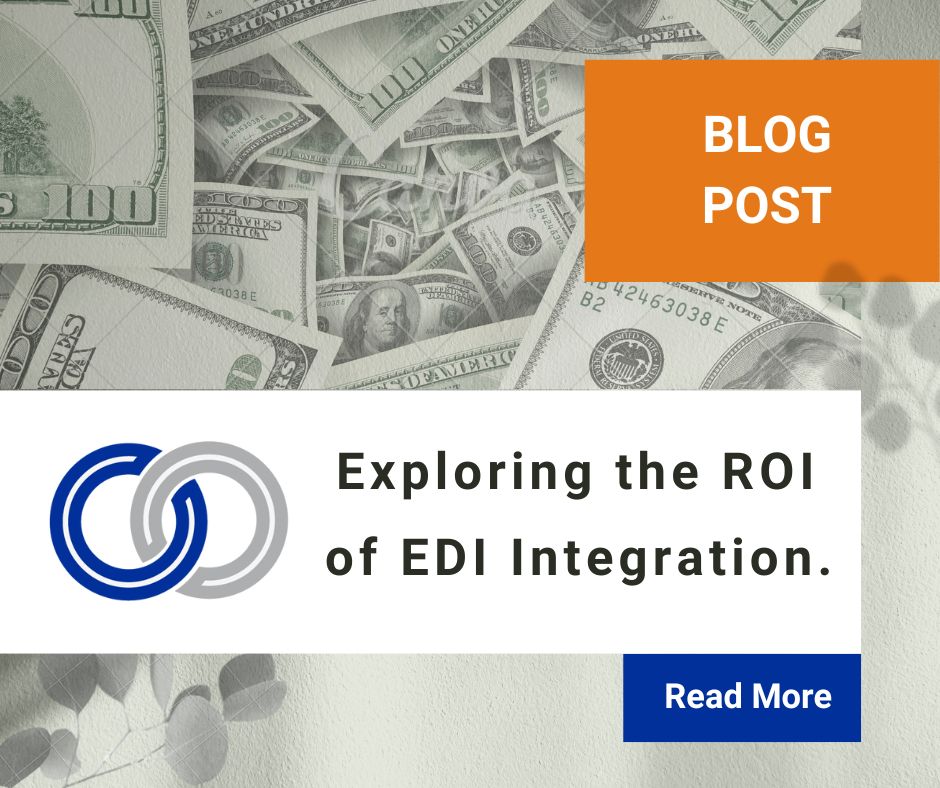 Chief Financial Officers (CFOs) and other C-suite roles that involve finance (think Chief Revenue Officer or Chief Business Officer) play a crucial part in driving an organization’s strategic direction. No longer confined to financial oversight, CFOs are increasingly turning to data-driven insights to optimize business operations, improve profitability, and foster growth. One of the most powerful tools at their disposal is Electronic Data Interchange (EDI) data. By leveraging EDI data, CFOs can gain a competitive edge, enhance financial decision-making, and unlock efficiencies across the organization. Below, we will outline the areas in which EDI data can transform financial strategy, from enhancing visibility and forecasting to cost reduction, risk management, and strengthening supplier relationships.
Chief Financial Officers (CFOs) and other C-suite roles that involve finance (think Chief Revenue Officer or Chief Business Officer) play a crucial part in driving an organization’s strategic direction. No longer confined to financial oversight, CFOs are increasingly turning to data-driven insights to optimize business operations, improve profitability, and foster growth. One of the most powerful tools at their disposal is Electronic Data Interchange (EDI) data. By leveraging EDI data, CFOs can gain a competitive edge, enhance financial decision-making, and unlock efficiencies across the organization. Below, we will outline the areas in which EDI data can transform financial strategy, from enhancing visibility and forecasting to cost reduction, risk management, and strengthening supplier relationships.
Table of Contents
- The Role of EDI in Financial Strategy
- Enhancing Financial Visibility and Forecasting
- Cost Reduction and Process Efficiency
- Strengthening Supplier and Customer Relationships
- Data Driven Decision Making and Risk Management
- How CFOs are Leveraging EDI Data with Tools Like VelociLink™
Financial Strategy
EDI facilitates the automated exchange of business documents such as invoices, purchase orders, and shipping notices between trading partners. This digital transformation eliminates manual data entry (or, at least it should), reduces errors, and accelerates order-to-cash and procure-to-pay cycles. From a financial perspective, EDI data provides CFOs with a real-time, granular view of financial operations, supplier performance, customer activity, cash flow trends, and revenue projections.
By integrating EDI data with ERP systems like D365 Business Central and other backend systems, CFOs can leverage this information to make strategic decisions that optimize working capital, reduce costs, and improve compliance.
Enhancing Financial Visibility and Forecasting
One of the most significant advantages of leveraging EDI data is improved financial visibility. With automated data flows and real-time reporting, CFOs gain insights into:
- Cash Flow Management: EDI data allows for real-time tracking of invoices, payments, and receivables, ensuring accurate cash flow forecasting. By identifying payment delays and optimizing accounts receivable processes, CFOs can take proactive steps to maintain liquidity and avoid cash shortages.
- Revenue and Expense Trends: By analyzing trends in sales, procurement, and expenditures, CFOs can make data-backed budgeting decisions. Identifying seasonal fluctuations or inefficiencies in spending enables better allocation of financial resources.
- Working Capital Optimization: CFOs can use EDI data to monitor payment cycles, negotiate better supplier terms, and adjust procurement strategies. With access to detailed transaction data, companies can strategically extend payables or accelerate receivables to maintain optimal working capital levels.
By using predictive analytics and machine learning on EDI data, CFOs can proactively address financial risks and opportunities before they impact the business.
Cost Reduction and Process Efficiency
Manual financial processes are not only time-consuming but also prone to errors and inefficiencies. By implementing integrated EDI, companies can achieve significant cost savings in several ways:
- Reduced Paperwork and Manual Processing: EDI automates transactions, eliminating the need for paper-based invoices, purchase orders, and shipping documents. This reduces administrative costs associated with printing, mailing, and storage while improving transaction speed.
- Lower Transaction Costs: Traditional paper-based transactions involve significant processing fees, labor costs, and potential errors that lead to financial losses. With integrated EDI, businesses can streamline transactions and cut costs by reducing the need for manual intervention and rework.
- Enhanced Accuracy and Compliance: Automated validation ensures that invoices, tax filings, and other financial documents comply with industry regulations. This reduces financial risks associated with errors, audits, and non-compliance penalties.
CFOs leveraging integrated EDI data can reallocate financial resources to higher-value strategic initiatives instead of dealing with operational inefficiencies.
Strengthening Supplier and Customer Relationships
Effective supplier and customer management is a key aspect of financial strategy. EDI data provides CFOs with critical insights into supply chain performance, helping them make informed decisions about vendor selection, pricing negotiations, and order fulfillment. This is especially true if you’re a retailer, but even suppliers can proactively manage customer relationships by monitoring their own performance.
- Supplier Performance Analysis: EDI data allows CFOs to track supplier reliability, delivery timelines, and pricing trends. By evaluating key performance metrics, CFOs can renegotiate contracts, switch to more reliable suppliers, or implement penalty clauses for late deliveries.
- Optimized Inventory Management: Real-time tracking of incoming and outgoing shipments enables just-in-time (JIT) inventory management. Whether JIT continues to be the strategy du jour remains to be seen in these uncertain times, or whether we might go back to frontloading inventory to avoid tariffs. However, the JIT strategy reduces excess stock, lowers storage costs, and ensures that inventory levels align with demand forecasts.
- Improved Customer Payment Behavior: Late or missed payments can impact cash flow stability. By leveraging EDI data, CFOs can track customer payment patterns, send automated reminders, and implement early payment discounts or late fee penalties to encourage timely transactions.
By leveraging EDI data, CFOs can strengthen financial stability and ensure long-term business partnerships that drive sustained growth.
Data-Driven Decision-Making and Risk Management
Risk management is a critical responsibility for CFOs. EDI data provides real-time visibility into potential financial risks such as late payments, supplier disruptions, and non-compliance issues. By integrating EDI analytics with risk management frameworks, CFOs can:
- Identify Fraudulent Transactions: Anomalies in transaction data can be detected early, reducing fraud risks. Suspicious purchase orders, duplicate invoices, or abnormal payment requests can be flagged for further investigation. Fraud will continue to be huge disruptor in the near and distant future.
- Monitor Market Trends: Macroeconomic indicators derived from EDI data can help CFOs anticipate market changes and adjust financial strategies accordingly. By analyzing industry-wide transaction patterns, businesses can make proactive pricing, investment, and operational decisions.
- Ensure Regulatory Compliance: Automated tax and compliance reporting reduce the risk of penalties and legal complications. EDI data ensures accurate tax calculations, timely reporting, and adherence to government or industry regulations.
By embracing data-driven decision-making, CFOs can minimize financial exposure and create resilient financial strategies.
How CFOs are Leveraging EDI Data with Tools Like VelociLink™
Historically, EDI data has been difficult to leverage without specialized technical knowledge. Many organizations struggled with extracting actionable insights from complex, raw EDI transactions, often requiring IT intervention and custom-built reporting solutions. This made it challenging for CFOs to access real-time financial insights and fully utilize the strategic potential of EDI data. Advanced tools like VelociLink™ are revolutionizing the way CFOs leverage EDI data for financial decision-making. VelociLink™, a supply chain analytics platform by GraceBlood, simplifies EDI data management by providing user-friendly dashboards and automated analytics, eliminating the need for deep technical expertise.
- Advanced Data Visualization: VelociLink transforms raw EDI data into interactive dashboards and reports. CFOs can quickly analyze key performance indicators (KPIs) such as order fulfillment rates, payment cycles, and cash flow trends.
- Predictive Analytics for Financial Planning: With AI-powered analytics, CFOs can forecast revenue trends, identify potential supply chain disruptions, and adjust financial strategies accordingly.
- Automated Alerts and Compliance Monitoring: VelociLink™ provides automated alerts for late payments, order discrepancies, and compliance issues, allowing CFOs to take corrective action before problems escalate.
- Integration with ERP and Financial Systems: Seamless integration with existing ERP platforms ensures that EDI data flows directly into financial systems, reducing manual reconciliation and improving accuracy.
By adopting tools like VelociLink™, CFOs can unlock deeper insights from their EDI data, enhancing strategic planning, cost control, and operational efficiency. The accessibility of these insights, without requiring technical expertise, empowers finance leaders to drive smarter, data-driven decisions with confidence.
It’s an EDI Data Driven World
CFOs who embrace EDI data as a strategic asset can drive efficiency, enhance financial visibility, and mitigate risks while positioning their organizations for sustainable growth. The automation, accuracy, and predictive capabilities of EDI data empower CFOs to make proactive, informed decisions that optimize financial performance and competitive positioning. As businesses increasingly adopt digital transformation, those who fully integrate EDI data with advanced analytics and financial management tools will gain a significant edge. Leveraging platforms like VelociLink™ ensures CFOs can harness the full potential of EDI data, leading to improved operational efficiencies, cost savings, and stronger supply chain relationships. Ultimately, the future of financial leadership lies in a data-driven approach. CFOs who leverage EDI data effectively will not only improve their organizations’ bottom line but also set the stage for long-term innovation, agility, and success in a now digital and global market that never stops evolving.








